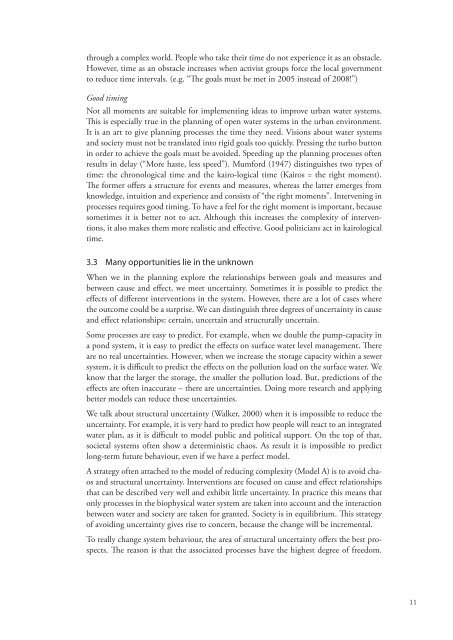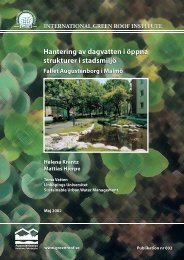New Approach to Sustainable Stormwater Planning - Visit WordPress
New Approach to Sustainable Stormwater Planning - Visit WordPress
New Approach to Sustainable Stormwater Planning - Visit WordPress
You also want an ePaper? Increase the reach of your titles
YUMPU automatically turns print PDFs into web optimized ePapers that Google loves.
through a complex world. People who take their time do not experience it as an obstacle.<br />
However, time as an obstacle increases when activist groups force the local government<br />
<strong>to</strong> reduce time intervals. (e.g. “The goals must be met in 2005 instead of 2008!”)<br />
Good timing<br />
Not all moments are suitable for implementing ideas <strong>to</strong> improve urban water systems.<br />
This is especially true in the planning of open water systems in the urban environment.<br />
It is an art <strong>to</strong> give planning processes the time they need. Visions about water systems<br />
and society must not be translated in<strong>to</strong> rigid goals <strong>to</strong>o quickly. Pressing the turbo but<strong>to</strong>n<br />
in order <strong>to</strong> achieve the goals must be avoided. Speeding up the planning processes often<br />
results in delay (“More haste, less speed”). Mumford (1947) distinguishes two types of<br />
time: the chronological time and the kairo-logical time (Kairos = the right moment).<br />
The former offers a structure for events and measures, whereas the latter emerges from<br />
knowledge, intuition and experience and consists of “the right moments”. Intervening in<br />
processes requires good timing. To have a feel for the right moment is important, because<br />
sometimes it is better not <strong>to</strong> act. Although this increases the complexity of interventions,<br />
it also makes them more realistic and effective. Good politicians act in kairological<br />
time.<br />
3.3 Many opportunities lie in the unknown<br />
When we in the planning explore the relationships between goals and measures and<br />
between cause and effect, we meet uncertainty. Sometimes it is possible <strong>to</strong> predict the<br />
effects of different interventions in the system. However, there are a lot of cases where<br />
the outcome could be a surprise. We can distinguish three degrees of uncertainty in cause<br />
and effect relationships: certain, uncertain and structurally uncertain.<br />
Some processes are easy <strong>to</strong> predict. For example, when we double the pump-capacity in<br />
a pond system, it is easy <strong>to</strong> predict the effects on surface water level management. There<br />
are no real uncertainties. However, when we increase the s<strong>to</strong>rage capacity within a sewer<br />
system, it is difficult <strong>to</strong> predict the effects on the pollution load on the surface water. We<br />
know that the larger the s<strong>to</strong>rage, the smaller the pollution load. But, predictions of the<br />
effects are often inaccurate – there are uncertainties. Doing more research and applying<br />
better models can reduce these uncertainties.<br />
We talk about structural uncertainty (Walker, 2000) when it is impossible <strong>to</strong> reduce the<br />
uncertainty. For example, it is very hard <strong>to</strong> predict how people will react <strong>to</strong> an integrated<br />
water plan, as it is difficult <strong>to</strong> model public and political support. On the <strong>to</strong>p of that,<br />
societal systems often show a deterministic chaos. As result it is impossible <strong>to</strong> predict<br />
long-term future behaviour, even if we have a perfect model.<br />
A strategy often attached <strong>to</strong> the model of reducing complexity (Model A) is <strong>to</strong> avoid chaos<br />
and structural uncertainty. Interventions are focused on cause and effect relationships<br />
that can be described very well and exhibit little uncertainty. In practice this means that<br />
only processes in the biophysical water system are taken in<strong>to</strong> account and the interaction<br />
between water and society are taken for granted. Society is in equilibrium. This strategy<br />
of avoiding uncertainty gives rise <strong>to</strong> concern, because the change will be incremental.<br />
To really change system behaviour, the area of structural uncertainty offers the best prospects.<br />
The reason is that the associated processes have the highest degree of freedom.<br />
11



